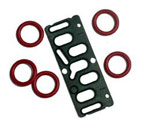
|
7108
S. Alton Way, Unit I |
(303) 758-2728
Home > Glossary of Terms > P Definitions
Glossary - P's
Paraffins saturated straight-chain hydrocarbons of the methane series.
Passivation (sc) the final layer in a semiconductor device, forming a hermetic seal over the circuit elements. Plasma nitride and silicon dioxide are materials primarily used for passivation.
Pellicle (sc) a thin film of an optical-grade polymer that is stretched on a frame and secured to a mask or reticle. This solves the problem of airborne contamination forming on the mask. The pellicle keeps the dirt out of the focal plane.
Perfluoroelastomer (r) a fully fluorinated fluoroelastomer.
Permanent set (r) the permanent distortion of an elastomer after being strained.
Permeability the permeation rate divided by the pressure gradient of the gas or vapor. For a homogeneous material that obeys Fick’s law, the permeability is equal to the product of the diffusion coefficient and the solubility coefficient of the gas or vapor.
Permeance the permeation rate divided by the pressure differential of a gas or vapor between opposite faces of a solid body.
Permeation rate the flow rate of a gas or vapor, under specified conditions, through a prescribed area of a solid body, divided by that area.
Physiosorption (r) a physical adsorption process in which there are van der Waals forces of interaction between gas or liquid molecules and a solid surface.
Phosphosilicate glass (PSG) (sc) a material commonly used for dielectrics before metalization, also for passivation. These films are composed of phosphorous-doped silicon dioxide.
Photoresist (sc) the light-sensitive organic polymer film spun onto wafers and “exposed” using high-intensity light through a mask. The exposed photoresist is dissolved with developers, leaving a pattern of photoresist which allows etching to take place in some areas while preventing it in others.
Physical vapor deposition (PVD) (sc) the layering of a vapor, usually by means of evaporation or “sputtering.”
Pigment (r) an insoluble compounding material used to impart color.
Plasma high-energy gas made up of ionized particles.
Plasma etching (PE) (sc) the use of energized gases to chemically remove a surface.
Plasma nitride (sc) a silicon-nitrogen film deposited using
PECVD, most often as a final passivation layer.
Plasma-enhanced chemical vapor deposition (PECVD) (sc) a deposition system primarily used for deposition of silicon oxide and silicon nitride films. A plasma is used in addition to a heat source which allows for lower temperature processing (200°–400°C).
Plasticizer (r) a compounding material used to enhance the deformability of a polymeric compound.
Polar describing a molecule or radical that has, or is capable of developing, electrical charges. Polar molecules ionize in solution and impart conductivity.
Polymer (r) a substance consisting of macromolecules characterized by the repetition (neglecting ends, branch junctions and other minor irregularities) of one or more types of monomeric units.
Polymer network (r) a three-dimensional reticulate structure formed by chemical or physical linking of polymer chains.
Polysilicon (Poly) (sc) polycrystalline silicon, extensively used as conductor or gate material in a highly doped state.
Porosity (r) the presence of numerous small cavities.
Post-cure (r) heat or radiation treatment, or both, to which a cured or partially cured thermosetting plastic or rubber composition is subjected to enhance the level of one or more properties.
Pot life (r) the period of time during which a reacting thermosetting plastic or rubber composition remains suitable for its intended use after mixing with a reaction-initiating agent.
Precision a concept of uniformity based on the magnitude of the random errors. The smaller the random errors, the higher the precision.
Primary accelerator (r) the principal, highest concentration accelerator used in a vulcanizing system.
Processability (r) the relative ease with which raw or compounded rubber can be handled in rubber machinery.
Processing aid (r) a compounding material that improves the processability of a polymeric compound.
(sc) This term is generally associated with the semiconductor industry.(r) This term is generally associated with the rubber industry.
Next Q's
Our specialty is solving sealing problems for original equipment manufacturers. We carry o-rings, seals, custom molded rubber parts, wipers, diaphrams, valves and u-cups in all types of materials including Kalrez®, FKM fluorocarbon, Simriz®, nitrile (buna-n), silicone, rubber, neoprene, polyurethane, TFE and FEP encapsulated.
We are located in the Denver Technological
Center in a suburb of Denver, Colorado
©1997-2017, Problem Solving Products, Inc.
Website Map | Privacy Statement
| Terms of Use

